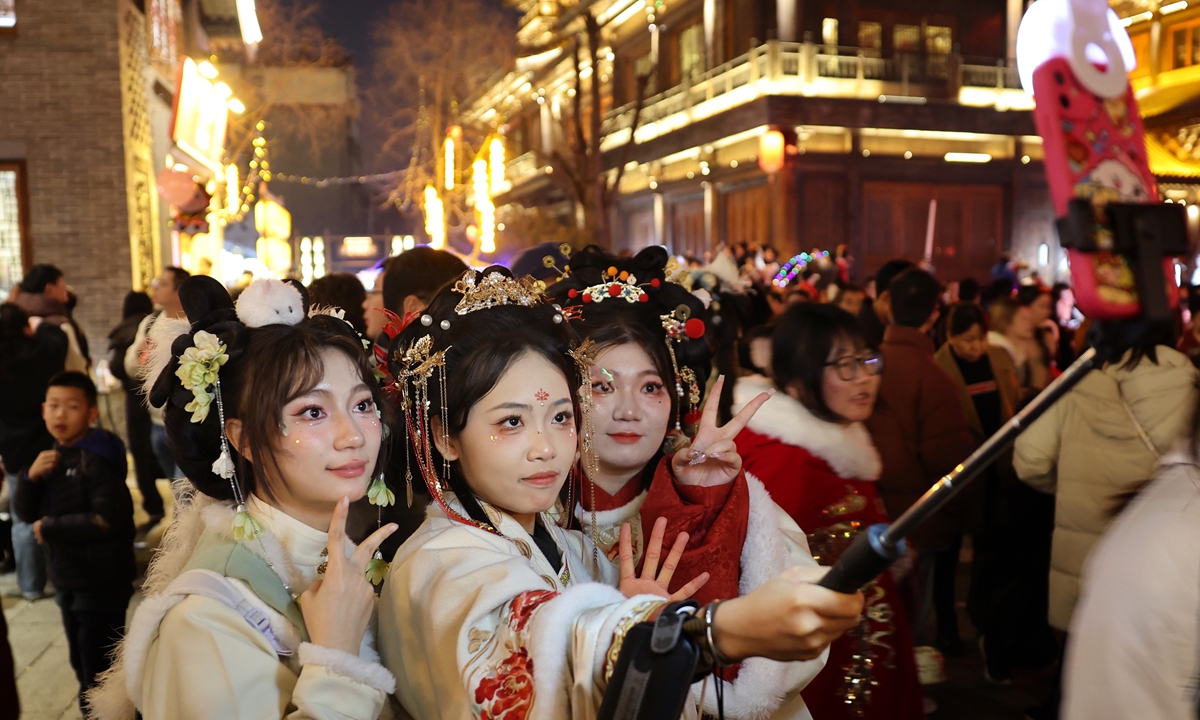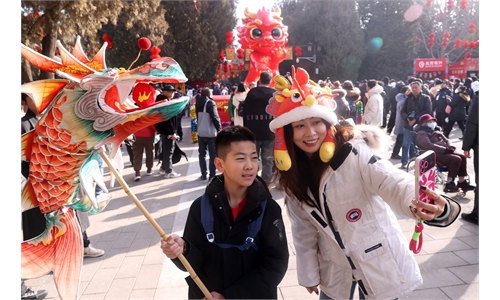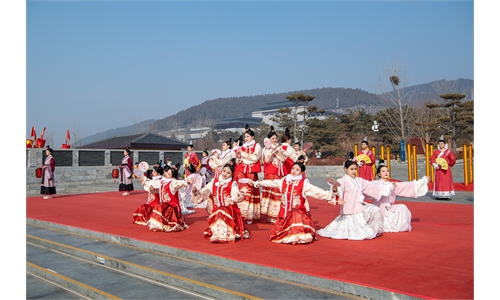Hometown witness: Central China’s Luoyang becomes Spring Festival hit with rich historical relics

Tourists dressed in Hanfu take photos and experience traditional Chinese culture in Luoyi ancient city in Luoyang, Central China's Henan Province, on February 13, 2024, the fourth day of the Chinese New Year. Photo: VCG
Luoyang, a city in Central China's Henan Province of 7 million people, experienced record popularity during the Spring Festival holidays, welcoming more than 11 million visitors, 80 percent more than 2023, and becoming a hit on social media.
Notably the city attracted younger visitors, 75 percent of whom were born post 1980 or 1990.
Visitors were fascinated with the historical relics such as Longmen Grottoes built through 4th to 10th centuries, the reconstructed palace halls which provide an imagination of the prosperous Tang Dynasty (618-907), the old city gate Lijingmen where tourists can try local snacks and buy unique souvenirs, and Luoyi ancient city, which is like a huge ancient-style theme park for young hanfu enthusiasts to relive ancient times.
Longmen houses tens of thousands of Buddhist statues across 2,345 caves which range from 25 millimeters to 17 meters in height. The biggest smiling Vairocana Buddha was said to have been patronized by the legendary empress Wu Zetian during the Tang Dynasty.
This scenic area across the Yihe River also houses the residence and tomb of Tang poet and Bai Juyi, who wrote the narrative poem "Song of Everlasting Sorrow" telling the love story of emperor Xuanzong of Tang and his concubine Yang Guifei.
However, the site, a UNESCO World Heritage Site since 2000, has never received as many visitors as this year's Spring Festival. Many locals jokingly said last time Longmen got so packed was 2005 when it charges no ticket fare.
Since online tickets were fully booked, many tourists chose to line up outside the entrance to the scenic spot as early as 6:30 am in the freezing cold to buy tickets reserved for walk up visitors arriving after the park opened at 8:00 am.
The Global Times reporter learned from several tourists that the Longmen Caves provided them an experience that combines the sacred sentiment of Buddhism, a glimpse into China in the vibrant Tang Dynasty, but also the modern day suffering resulting from Buddhas looted overseas during the first half of 20th century.
It is also an auspicious thing to visit Longmen, the dragon gate, in the Year of the Dragon, a visitor from Hangzhou, East China's Zhejiang Province told the Global Times.
Another place that offers a unique cultural experience is the Mingtang (Hall of Enlightenment) and Tiantang (Heavenly Hall) Scenic Area, which were reconstructed on their original sites on the city axis of Luoyang city in Sui and Tang dynasties. The Mingtang was the hall Empress Wu Zetian listened to cabinet ministers and issued political orders; the Tiantang was Wu's royal hall to worship the Buddha.
The two halls provided exhibitions on the history of Luoyang in ancient times and routine performances. During the Spring Festival, this area, and the adjacent Yingtianmen Gate was transformed into a huge entertainment venue where tourists were able to watch light shows, lanterns, dragon dance and old magic tricks from ancient times.
"The interactive performance was so much fun. Can you imagine I talked to Di Renjie (the Tang Dynasty's famous detective and judge)?" a tourist surnamed Lin told the Global Times with excitement after watching the performance that resembled a Tang Dynasty New Year grand gathering.
Another popular interactive performance was a royal banquet where visitors became ambassadors of various countries to witness the splendor of music and dance but also the political competition of different parties.
"Ancients dress up" was also a major draw to Luoyi ancient city. Luoyi was the name of the city dating back 3,000 years to Zhou Dynasty (1046BC-221BC).
The ancient town has long perished in history due to wars and migration, but it now thrives as a popular site for young hanfu enthusiasts to dress up as their ancient forebears.
Jiang Wenting, a Luoyang native, brought her sister-in-law to Luoyi ancient city on February 11, the second day of the Chinese Lunar New Year. "We arrived as early as 9 am and there were already dozens of young girls and couples waiting before us. We got the hair and makeup done at nearly 2 pm," Jiang told the Global Times, "I knew it is popular, but not to this level."
Museums were also popular and several visitors shared with the Global Times their amazement. The archeological museum displayed different burial styles and worship rituals throughout Chinese history, and also explained the philosophy of "life and death" Chinese culture; it is a less well known than other museums but very interesting, a tourist from Northwest China's Shaanxi said.
The Erlitou Relic Museum demystified the first dynasty of Chinese history - Xia (c.2070BC-c.1600BC). Bronze wares, ruins of palaces and work plants, China's earliest urban road network and the remains of two-wheeled chariots, told the story of the Chinese civilization in its early date.
The museum is not close to the city center, but the bullet train was convenient. "It is great to see so many relics that tell us where China originates and how the etiquette, a core part of Chinese culture, takes form," a tourist surnamed Zhao told the Global Times.
The popularity of Luoyang demonstrated that the strength of culture is profound and has its appeal for the young people, analysts said, advocating the city to continue to explore the richness of history and culture, and use of innovate formats to maintain its attraction for younger audiences.


